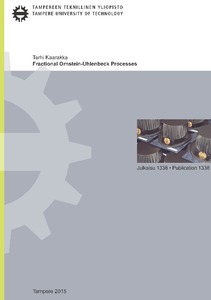Fractional Ornstein-Uhlenbeck Processes
Kaarakka, Terhi (2015)
Kaarakka, Terhi
Tampere University of Technology
2015
Luonnontieteiden ja ympäristötekniikan tiedekunta - Faculty of Science and Environmental Engineering
This publication is copyrighted. You may download, display and print it for Your own personal use. Commercial use is prohibited.
Julkaisun pysyvä osoite on
https://urn.fi/URN:ISBN:978-952-15-3620-5
https://urn.fi/URN:ISBN:978-952-15-3620-5
Tiivistelmä
In this monograph, we are mainly studying Gaussian processes, in particularly three different types of fractional Ornstein – Uhlenbeck processes. Pioneers in this field may bementioned, e.g. Kolmogorov (1903-1987) and Mandelbrot (1924-2010).The Ornstein – Uhlenbeck diffusion can be constructed from Brownian motion via a Doobtransformation and also from a solution of the Langevin stochastic differential equation. Both of these processes have the same finite dimensional distributions. However the solution of the Langevin stochastic differential equation, which driving process is fractionalBrownian motion and a Doob transformation of fractional Brownian motion do not havesame finite dimensional distributions. Indeed we verify, that the covariance of the fractionalOrnstein – Uhlenbeck process of the first kind (which we call the solution of the Langevin stochastic differential equation in which the driving process is fractional Brownian motion) behaves at infinity like a power function and the covariance of the fractional Ornstein –Uhlenbeck process (constructed by a Doob transformation of fractional Brownian motion) behaves at infinity like an exponential function. Moreover we study the behaviour of the covariances of these fractional Ornstein – Uhlenbeck processes. We also calculate the spectral density function for the Doob transformation of fractional Brownian motion using a Bochner theorem.We present the Doob transformation of fractional Brownian motion via solution of the Langevin stochastic differential equation. One of the main aims of our research is to analyse its driving process. This driving process is Y^((α))=e^(-tα) x_(τ_t ), where τ_t=(He^(αt/H))/α and {Z_t:t≥0 } is fractional Brownian motion. We find out that the process Y^((α)) := {Y_t^((α)): t ≥0}, if scaled properly, has the same finite dimensional distributions as the process Y^((1)) := {Y_t^((1)): t ≥0}. The main result in this monograph is that we define a stationary fractional Ornstein – Uhlenbeck process of the second kind as a process with a two-sided driving process {Y ̂_t^((1)): t∈R} and create a new family of fractional Ornstein-Uhlenbeck processes. We study many properties of the fractional Ornstein – Uhlenbeck process of the second kind. For example, we show that the fractional Ornstein – Uhlenbeck process of the second kind is Hölder continuous of any order β < H and find the kernel representation of its covariance.We research many properties of the processes Y^((α)) and Y^((1)) since they are quite interesting themselves. We represent these processes as stochastic integrals with respect to Brownian motion and prove that the sample paths of the process Y^((α)) are Hölder continuous of any order β < H. In the case H ∈(1/2,1), we find out the covariance kernel of increment process of Y^((α)), and using that we investicate the covariance of Y^((α)) and the variance of Y^((α)), when t tends to infinity. One of our main results is that the increment process of Y^((α)) is short-range dependent. We also study weak convergence and tightness and then finally prove that 1/√α Y_αt^((α)) converges weakly to scaled Brownian motion.In the case H ∈(1/2,1), fractional Brownian motion and the fractional Ornstein – Uhlenbeck process of the first kind both exhibit a long-range dependence, but the fractional Ornstein– Uhlenbeck process of the second kind exhibits a short-range dependence. This offers more opportunities to model network traffic or economic time series via tractable fractional processes. The fractional Ornstein – Uhlenbeck process of the first kind and the fractional Ornstein – Uhlenbeck process of the second kind are quite similar to simulate, since they can both be represented via stochastic differential equations.
Kokoelmat
- Väitöskirjat [4773]
